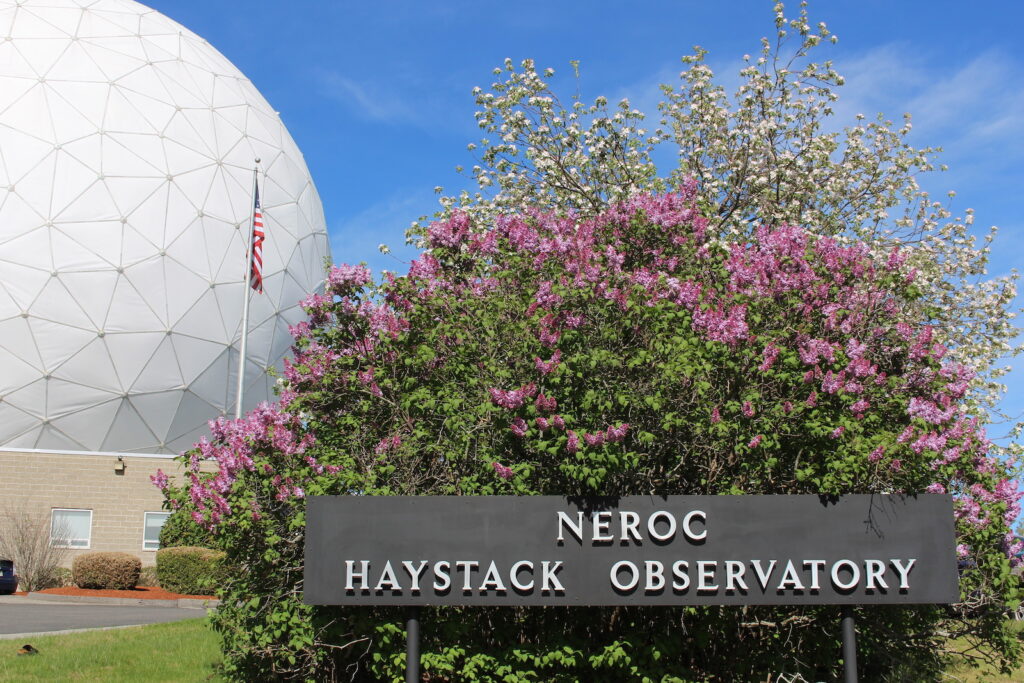
Haystack 37m Radio Antenna & Radome
MIT Haystack Observatory
MIT Haystack Observatory is an interdisciplinary radio science research center whose mission is to advance scientific research and technological developments in radio astronomy, geodesy (the study of the earth’s size, rotation, and gravitational field), and geospace science (the study of space weather conditions between the sun and the earth).
Download the Haystack 37m Radio Antenna & Radome brochure
Radio telescope and radome
The MIT Haystack Observatory radio telescope is 37 meters (120 feet) in diameter. The original construction of the telescope and its radome (a word derived from “radar” and “dome”) was completed in 1964. The telescope is used for radar satellite imaging and orbital debris tracking by MIT Lincoln Laboratory and for radio astronomy by MIT Haystack Observatory. Its dish is a parabolic antenna, part of a Cassegrain antenna design. The radome itself is 46 meters (150 feet) in diameter, and contains 932 triangular membranes of hydrophobic material designed to minimize interference with radio signals. It is the world’s largest radome for this type of enclosed antenna.

This type of radome was originally designed for use in arctic conditions and high winds. By protecting the telescope structure from the environment, the radome enclosure makes it possible to operate the MIT Haystack Observatory telescope under a great variety of New England weather conditions. The protected, stable interior environment facilitates accurate pointing and calibration.
The Haystack antenna is used to conduct single-dish radio astronomy in the 22–25 GHz (K), 35–50 GHz (Q), and 85–115 GHz (W) frequency bands. Haystack is also used by MIT Lincoln Laboratory as a contributing sensor to the United States Space Surveillance Network and as a radar technology testbed.
In 2014, work was successfully completed on a major telescope upgrade: the Haystack Ultrawideband Satellite Imaging Radar (HUSIR). This project included removing the top of the radome (the “cap”); replacing much of the telescope structure inside, including the main reflector, which has an accuracy of 0.1 millimeter (0.004 inch) over its entire surface; and restoring the radome cap. Hardware was also installed to allow rapid switching between radar and radio functions, along with many other significant technical improvements.
The radome, which may seem to be randomly assembled, is actually a specially designed geometric shape called a trapezoidal hexecontahedron. This configuration was selected to achieve adequate structural strength with minimal blockage of incoming radio signals.
Antenna and radome figures
- The radome is 46 meters (150 feet) in diameter; the antenna within is 37 meters (120 feet) across and was built to fit within the radome.
- The total radome surface is more than 1.5 acres and is made of a manmade fabric with a hydrophobic coating, designed for minimal attenuation of radio waves.
- There are 932 triangles of 15 different shapes, made of a 0.036-in. layer of this coated fabric.
- The space frame is made of hollow extruded aluminum beams that are 3 × 5 inches in cross-section and range from 9 feet to 15 feet in length.
- The frame is held together by 15 tons of nuts, bolts, and washers. There are 1,375 frame beams, with an aggregate length of three miles.
- The radome is designed to withstand windspeeds greater than 100 mph.
- The new antenna weighs about 675,000 pounds: almost twice the original antenna.